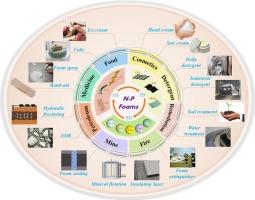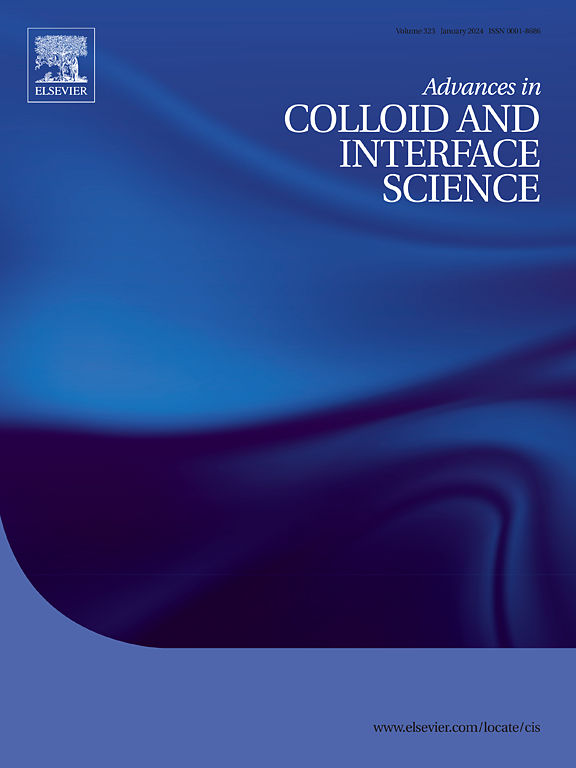Nanomaterials-based Pickering foams: Stabilization, morphology, rheology, and perspectives
IF 19.3
1区 化学
Q1 CHEMISTRY, PHYSICAL
引用次数: 0
Abstract
Increasing demand for foams in various industries and processes necessitates foams with high stability. However, the most widely used surfactants as foaming stabilizers are not sufficient to meet this requirement, particularly under extreme conditions. Recently, nanomaterials have emerged as an effective solution to improve foam stability, alter foam morphology, and control foam flow behavior. This review highlights key advancements in Pickering foams stabilized by various nanomaterials, which are categorized into three distinct types according to their spatial scale and structure: zero-dimensional (0D) nanomaterials (e.g., inorganic nanoparticles, organic nanoparticles, nanodots, etc.); one-dimensional (1D) nanomaterials (e.g., cellulose nanofibers, cellulose nanocrystals, chitin nanofibrils, etc.); and two-dimensional (2D) nanomaterials (e.g., graphene oxide nanosheets, molybdenum disulfide nanosheets, etc.). These nanomaterials work by stabilizing foam fluids at the interface and within the bulk liquid phase. The nanomaterials induce a shift from a liquid-like interface to a solid-like or gel-like state, altering the morphology of foams. The rheological properties of interface and bulk phase are intricately linked to the micron-scale structure of nanomaterials, ultimately dictating the rheology of foam fluids. Based on the special flow behavior of Pickering foams enhanced by nanomaterials, the mobility of liquid or gas in porous media can be controlled effectively. Finally, current applications of advanced nanomaterial-based Pickering foams are summarized, and the need for further exploration is underscored. The study holds promise to advance the creation of new nanomaterials and the expansion of applications for Pickering foams.

基于纳米材料的皮克林泡沫:稳定性、形态、流变性和前景
各种工业和工艺对泡沫的需求不断增加,要求泡沫具有高稳定性。然而,最广泛使用的表面活性剂作为泡沫稳定剂不足以满足这一要求,特别是在极端条件下。近年来,纳米材料已成为提高泡沫稳定性、改变泡沫形态和控制泡沫流动行为的有效解决方案。本文综述了各种纳米材料稳定皮克林泡沫的关键进展,根据其空间尺度和结构将其分为三种不同的类型:零维(0D)纳米材料(如无机纳米颗粒、有机纳米颗粒、纳米点等);一维纳米材料(如纤维素纳米纤维、纤维素纳米晶体、几丁质纳米原纤维等);二维(2D)纳米材料(如氧化石墨烯纳米片、二硫化钼纳米片等)。这些纳米材料的工作原理是在界面和散装液相中稳定泡沫流体。纳米材料诱导从液体界面到固体或凝胶状态的转变,改变泡沫的形态。界面和体相的流变性能与纳米材料的微米级结构有着复杂的联系,最终决定了泡沫流体的流变性能。基于纳米材料增强的皮克林泡沫的特殊流动特性,可以有效地控制液体或气体在多孔介质中的流动。最后,总结了先进纳米材料基皮克林泡沫的应用现状,并强调了进一步探索的必要性。这项研究有望推动新纳米材料的创造,并扩大皮克林泡沫的应用范围。
本文章由计算机程序翻译,如有差异,请以英文原文为准。
求助全文
约1分钟内获得全文
求助全文
来源期刊
CiteScore
28.50
自引率
2.60%
发文量
175
审稿时长
31 days
期刊介绍:
"Advances in Colloid and Interface Science" is an international journal that focuses on experimental and theoretical developments in interfacial and colloidal phenomena. The journal covers a wide range of disciplines including biology, chemistry, physics, and technology.
The journal accepts review articles on any topic within the scope of colloid and interface science. These articles should provide an in-depth analysis of the subject matter, offering a critical review of the current state of the field. The author's informed opinion on the topic should also be included. The manuscript should compare and contrast ideas found in the reviewed literature and address the limitations of these ideas.
Typically, the articles published in this journal are written by recognized experts in the field.

 求助内容:
求助内容: 应助结果提醒方式:
应助结果提醒方式:


